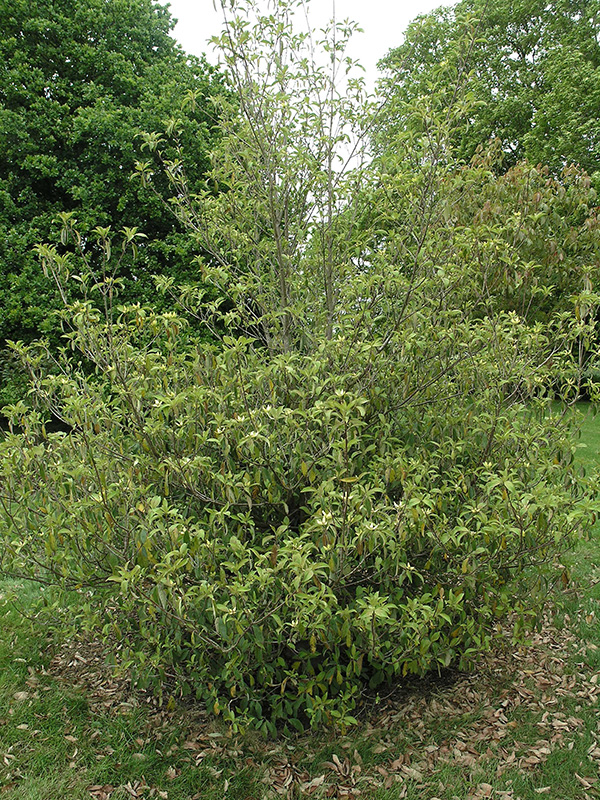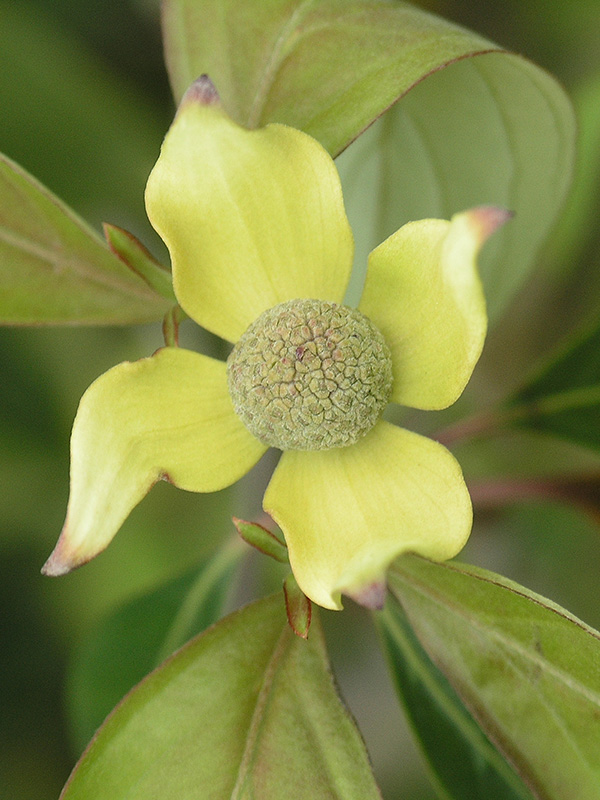
Woody > Cornus > Cornus capitata > Cornus capitata
Cornus capitata
Bentham's Cornel
Origin: Himalayas, Nepal.
Mike's
Opinion


"
Bentham`s Cornel is an attractive border shrub, feature plant or woodland garden plant that can reach a height of 20 m in ideal conditions. Its creamy white bracts are stunning May through July and its red berries are eye catching in autumn through the winter months. This tree can create a mess in your garden as it is self-seeding and may become weed-like as the seeds are spread naturally and by feeding birds and small animals.
Michael Pascoe, NDP., ODH., CLT., MSc. (Plant Conservation)
"
| Family |
| Cornaceae |
| Genus |
| Cornus |
| Species |
| capitata |
| Category |
| Woody |
| Type |
| Tree (evergreen), Shrub (evergreen) |
| Pronunciation |
| USDA Hardiness Zone |
| 8 - 9 |
| Canadian Hardiness Zone |
| 7b - Requires cool season protection under glass. |
| RHS Hardiness Zone |
| H3 - H5 |
| Temperature (°C) |
| -12-(-1) |
| Temperature (°F) |
| 10 - 30 |
| Height |
| 6 - 12 m |
| Spread |
| 6 - 12 m |
Photographs
Description and Growing Information
Flowering Period
| General Description |
| A mounding shrub or rounded tree with dark green leaves that persist year round. It presents creamy white bracts in the spring and red, strawberry-like berries in the autumn. |
| Landscape |
| Cornus capitata can be used as a border shrub or as a feature tree in large gardens. The fruit attracts birds and small animals but it also creates a large amount of litter, so do not plant Bentham’s Cornel near high traffic areas. |
| Cultivation |
| Bentham’s Cornel is an easily grown plant that succeeds in most conditions, adaptable to many soil types including loamy, sand, clay and peat. Preferring a pH range of 5-7 and partial shade to full sun. |
| Shape |
| Mounding shrub or rounded tree. |
| Growth |
| Medium |
| ID Characteristic |
| Leathery dark green leaves that are finely pubescent above and densely pubescent below. It has small, flowers in the spring that are surrounded by four creamy, white bracts; these are its show piece. Red, strawberry-like, edible fruit is produced in the autumn. |
| Pests |
| Cornus capitata may suffer from Coral spot and Honey Fungus. Coral Spot can be pruned out while Honey Fungus has no remedy. Cornus capitata appears to be resistant to Cornus anthracnose, a disease that is common in other Cornus species. |
| Habitat |
| Cornus capitata grows in evergreen and mixed forests at an elevation of 3,400 m in the Himalayas. |
| Bark/Stem Description |
| Older bark is brown to black-grey and glabrous while young bark is grey-green and pubescent. |
| Flower/Leaf Bud Description |
| Flowering buds are 1.5 cm and globose in shape. The buds are exposed and subtended by four lanceolate bracts. |
| Leaf Description |
| The leaves are opposite, simple and lanceolate to ovate in shape. They are 5-12 cm in length and 2-5 cm wide. The top of the leaf is dark green, leathery and finely close pubescent, the underside is grey-green with dense appressed pubescence. The leaves turn red to purple in the autumn. |
| Flower Description |
| Flowers are perfect, the inflorescence is a dull green and insignificant. They are subtended by four creamy white lanceolate bracts that are 2-4 cm wide and 4-8 cm in length. |
| Fruit Description |
| This fleshy, strawberry-like fruit is 2.5 cm across, 1 cm in length and turns from green to crimson red as it ripens, it is edible, however it can be quite bitter. |
| Colour Description |
| The foliage is deep green turning to red or purple in the autumn. In the spring Cornus capitata bears creamy white bracts that surround insignificant green flowers. Red berries are present in the autumn and persist throughout the winter months. |
| Texture Description |
| Medium. |
| Notable Specimens |
| The Lost Gardens of Heligan, Cornwall, England, has an avenue of Cornus capitata lining the driveway. |
| Propagation |
| It can be propagated from seed or cuttings. Seed is best sown when the fruit is ripe in autumn, the fruit flesh must be fully separated from the seed as it contains germination inhibitors. The seed requires several months in a cool temperature to germinate, producing flowers in 8-10 years. Cuttings are taken from softwood immediately after first bloom in spring. Dip the cuttings into 1,000-3,000 IBA talc rooting hormone and place in a well drained soil. Cover the cuttings and keep moist and humid while roots develop; about 4-6 weeks. |
| Ethnobotanical Uses (Disclaimer) |
| The tannin and antibacterial phytochemicals in the bark are used for medicinal purposes. |
References
"Cornus capitata." Missouri Botanical Garden. Missouri Botanical Garden, n.d. Web. 24 Feb. 2013.
Hatch, Laurence C. "Cornus capitata." Cultivars of Woody Plants Volume I A-G. North Carolina: TCR, 2007. N. pag. Print.

